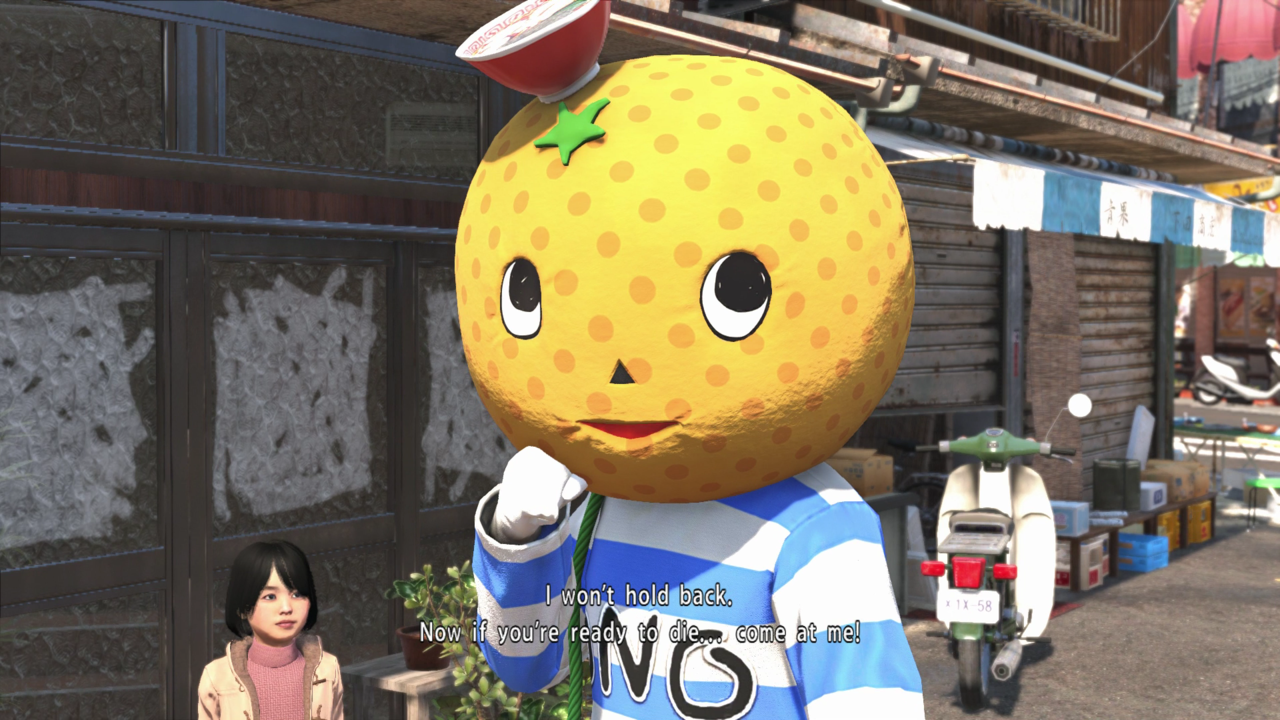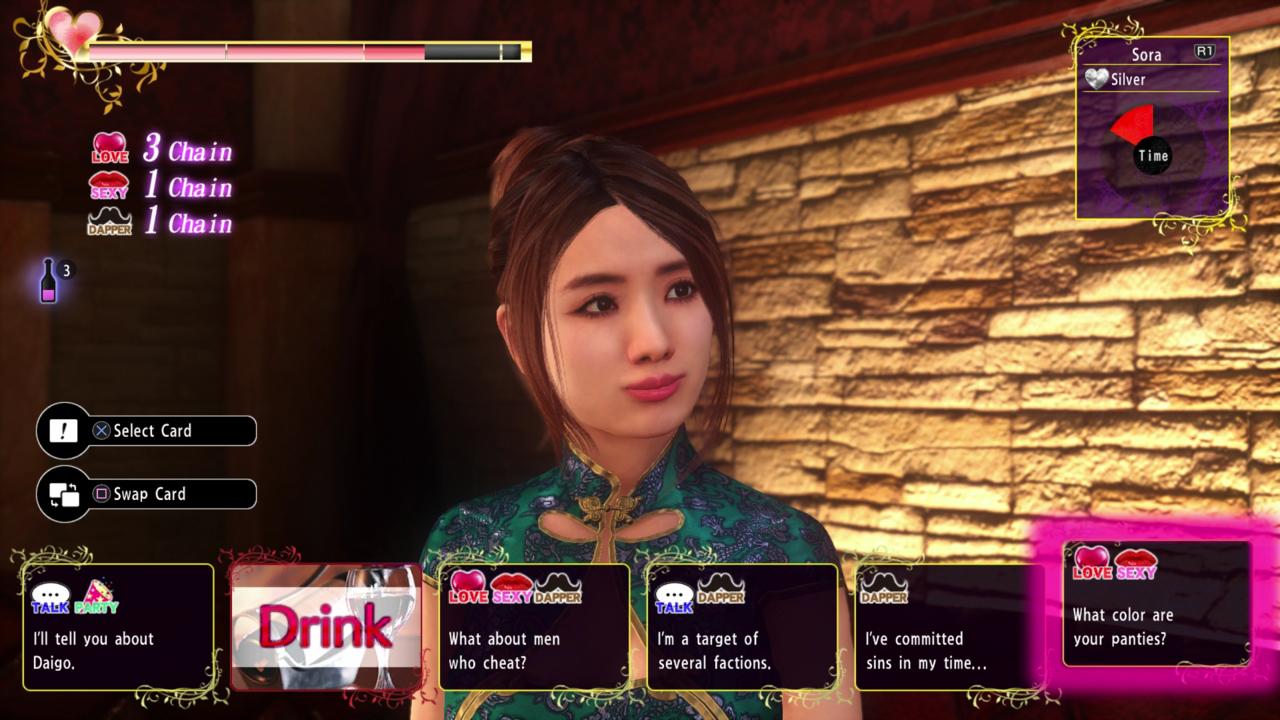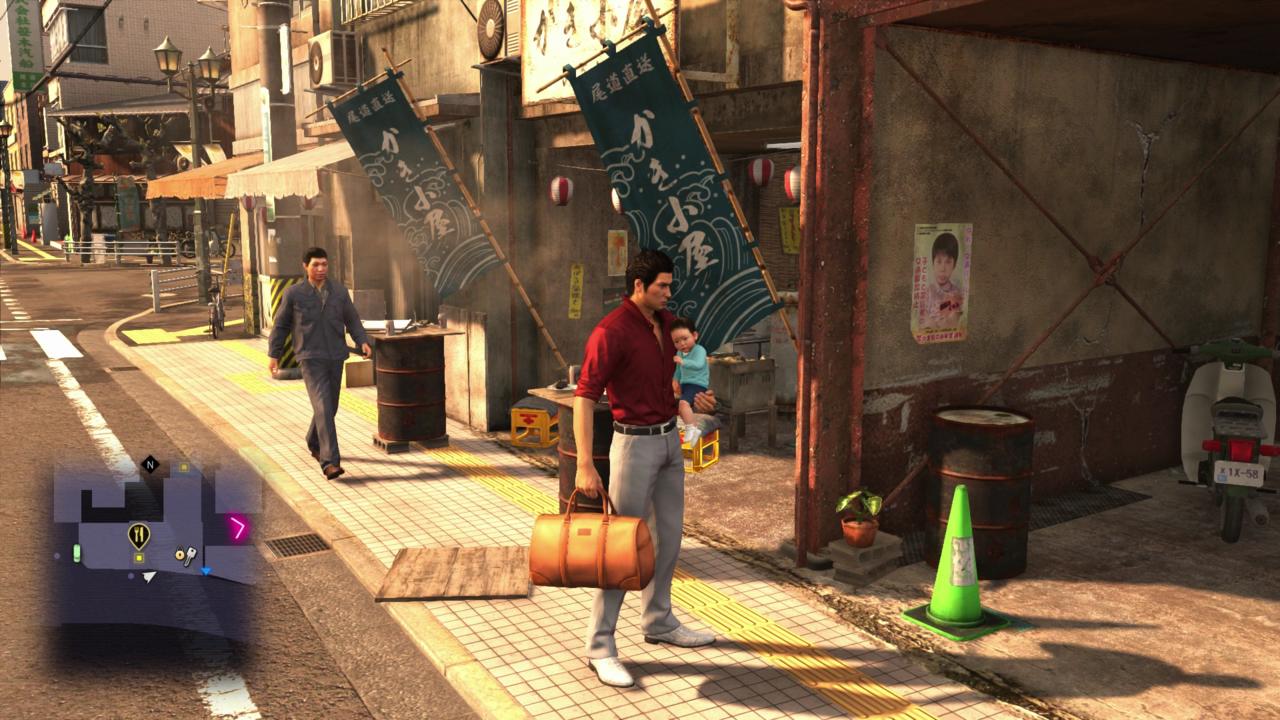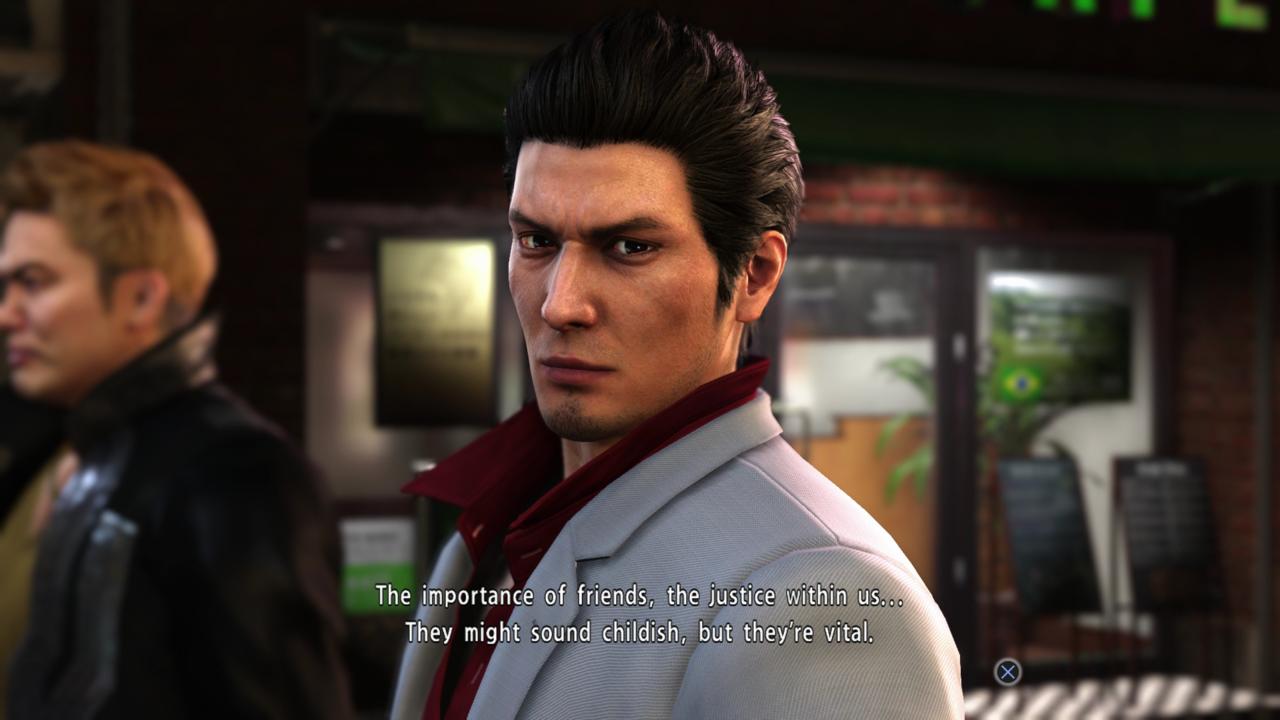The Yakuza franchise is over a decade old, and in that time, its feature set has predictably grown. Over six mainline entries, free-roam areas became more substantial, additional playable protagonists were introduced, combat mechanics were expanded to incorporate multiple fighting styles, and more and more minigames were steadily piled on. Surprisingly, the latest installment goes the other way, discarding components that certainly won't go unnoticed by series devotees. But that doesn't end up being a bad thing, because Yakuza 6: The Song of Life successfully uses its smaller footprint to create a deeper, more meaningful impression.
The final installment in Kazuma Kiryu's story focuses on him alone, with the plot seeing the large cast of series-significant characters like Majima, Saejima, Daigo, and the children of Sunflower Orphanage make only the briefest of appearances before being tidied away. Adopted daughter Haruka, sympathetic detective Date, and hobo-turned-loan broker Akiyama play important parts, but exist on the fringes. The Song of Life centers on Kiryu as he returns from another long stint in prison, separated from the Tojo Clan, and unravels the mystery of an infant who's suddenly come into his care. The setup distinctly echoes the events of the first game, a seemingly purposeful decision which lets The Song Of Life act as a fitting refrain, giving Kiryu's final sojourn a roundness that brings a nice sense of closure to his series arc.
His investigations bring him to the port town of Onomichi, Hiroshima, where he encounters a lowly blue-collar crime family led by an aging, but supposedly legendary yakuza portrayed by Takeshi "Beat" Kitano (a yakuza film icon in his own right, though his subtle mannerisms don't completely survive the transition). While the game unsurprisingly spirals into a complex and dramatic story involving underworld political alliances, age-old conspiracies, and a healthy dose of deception, what's ultimately memorable are the threads and character developments that explore what becomes a very significant, widespread theme: family. Kiryu's time meeting new people from different walks of life in a closely-knit small town has him reflecting on remarkably ordinary ideas as they exist in different facets of society--bonds of friendship in the face of adversity, loyalty in times of uncertainty, and caring for your ward as a parental figure.
These themes resonate consistently throughout the better part of Yakuza 6's narrative, and this includes the numerous, optional substories. You'll help children and parents resolve conflicts and try to understand each other's point of view. You'll see Kiryu finding true strength and loyalty in the smallest of gestures, along with the different ways friends and strangers can support one another. The writing in these stories is often corny, but that doesn't mean there isn't an endearing sincerity that regularly shines through. When the sentimental piano melody kicks in during pivotal scenes of moralistic resolution, it's hard not to be swept up by it all. The series' penchant for goofiness still exists, though it doesn't return to Yakuza 0's ludicrous levels of absurdity. Particularly memorable substories are ones which humorously explore Kiryu's unfamiliarity and disdain towards modern technology like drones, robot vacuums, and YouTubers. But even the game's most comedic series of quests, which involve Kiryu dressing up as Onomichi's adorable character mascot (who has an orange for a head and a fish for a purse) ends up becoming a touching reflection about having loyalty in town pride.

These heartwarming stories are also a key component of Yakuza 6's new minigames. There are less of these side activities than previous entries, but much of what's included is more robust than usual, and in many cases, the substories attached to them are enjoyable enough to stop the simple mechanics from wearing thin too quickly. Spear Fishing is a score-based on-rails shooter that finds Kiryu helping an injured fisherman and orphaned fishmonger track down the shark that ruined their lives. The Onomichi Baseball League involves some light team management, pinch-hitting, and player scouting, but the story of Kiryu rallying a team of no-hopers is what really makes the whole affair great. The Snack Bar minigame stands out as a real highlight in this regard. It involves attempting to become a regular in a small, Cheers-style local's bar where Kiryu tries to forge personal relationships with a group of relatively unextraordinary, blue-collar folk. Its key mechanic is participating in group conversations where one patron has a vent about their woes, and Kiryu's role is to help provide supportive dialogue and refrain from saying anything selfish or dumb. It's lovely to see Kiryu try to resolve everyday, down-to-earth dilemmas and provide genuine acceptance and friendship.
Conversely, there's the incredibly involved Clan Creator Mode, which sees Kiryu unwittingly intervening in a war between youth gangs (whose leaders include real-world New Japan Pro Wrestlers, because why not). Taking leadership of one of these groups, you'll help Kiryu scout for soldiers, organize hierarchy, and participate in simple, real-time strategy-style street battles. You'll take a bird's eye view in skirmishes, where you can dispatch autonomous grunts as well as a limited number of leader characters with special abilities. Clan Creator is Yakuza 6's most substantial minigame, boasting online network functions that let you compete against other players, tackle daily missions and participate in a ranked ladder. Unfortunately, it's also the most tedious to play. Victory strategies stem entirely from massing as many troops as possible and grinding missions to keep your leaders at a capable level. Battles don't really become challenging until the many substory missions are already done, and even then, the strategy more or less stays identical. For a mode with such ambitious scope, its mechanics and relatively uninspired plot--which mainly seems concerned with spotlighting its celebrity guests--aren't satisfying enough to make the long ride enjoyable.
Elsewhere, the Club Sega arcade once again offers playable classics like Super Hang-On and Outrun, but there's also complete, multiplayer-capable versions of puzzle action favorite Puyo Puyo, and the seminal Virtua Fighter 5: Final Showdown, both robust offerings in their own right. Mahjong is back, a gym offers track-and-field-style minigames for above average experience gains, karaoke and a cat cafe provide enjoyable distractions, and a simple-to-master darts minigame features a substory that lets you take on a real-world darts legend.
Yakuza 6 also maintains the series convention of including more titillating pursuits. Cabaret clubs return, with a choice of six hostesses for Kiryu to woo through conversation minigames. Also notable is the particularly risque Live Chat, a minigame which sees you pay money to watch live-action webcam shows (featuring real-world AV idols, no less), while hitting button prompts to progress to the point where you can watch the models strip their clothes off and moan suggestively. The unambiguous objectification of women in these minigames continues to make their inclusion uncomfortable in their own right. Their presence does truthfully reflect prominent parts of the real-world Japanese nightlife and adult industries, but these kinds of minigames have always perpetuated an unbelievable inconsistency of character for Kiryu. There's a conflict between the canonical depiction of him as a strong, stoic, honorable saint, and a version who is a creepy, bumbling pervert. After ten years, it's still hard to believe Kiryu is someone looking to build a harem as big as the orphanage he owns, who madly exclaims "BOOOBS" and "IT'S GROWING" when a woman takes her top off. These activities do have their moments, though--the text-based quips of Live Chat participants can sometimes be laugh-out-loud funny, and courting hostesses mean you get to see additional, phenomenally good karaoke videos. But in the grand scheme of Yakuza 6, where heartfelt themes pervade all of Kiryu's character interactions, these minigames feel like distant outliers.

The iconic red-light district of Kamurocho still plays a big part in the story, though it has a noticeably smaller area size this time around. You'll still feel at home if you've visited the area before, but there is a significantly disappointing lack of access to the Champion District and Park Boulevard areas. However, the distinct sense of a vibrant, bustling city still remains, and that's amplified by what feels like a more detailed and densely populated world. Walking around in the first-person mode is enough for you to appreciate all the surface level intricacies and changes, and there's a new element of verticality with increased rooftop access. But there are also some great advancements in the way the city invites you to engage with it.
Yakuza 6 now rewards you for interacting with the world in a way that previous games didn't. Eating at the game's many restaurants, which was previously really only worth doing if you needed a health boost, is now the most convenient way to rack up experience points to spend in the game's extensive upgrade system, though you're limited by a new stomach capacity meter. Purchasing and drinking beverages from one of the numerous vending machines around the world will give you cheap, temporary combat buffs. Every mini-game, from the batting cages to playing a round of Space Harrier will also earn you experience. The result is that slowing down and taking your time to soak in the atmosphere of the city will benefit you, and the world is no longer just a pretty path for you to run down to get to your next objective. Now, you don't necessarily have to feel guilty for letting yourself be distracted by Mahjong for hours.

Onomichi, Hiroshima is a region that is larger than previous accompanying locales have been, although the sleepy port town is a much quieter, more unassuming area than Kamurocho. Situated by the seaside, cute greenery arrangements line its single-story businesses, an above-ground train splits the area, and narrow pedestrian walkways snake up the steep hills, leading to an impressive temple with spectacular views. It's a charming, authentic-feeling recreation of the more tranquil parts of Japan, which both you and Kiryu learn to cherish. The town's relaxed atmosphere and characters exemplify the Song of Life's wholehearted themes.
Of course, in order to keep that tranquillity, sometimes you need to pound a few dirtbags into the ground, and the game's updated combat system follows its philosophy of slimming and focussing. Gone are the variable fighting disciplines introduced in Yakuza 0--the Kiryu of Yakuza 6 is equipped only with an expanded version of his signature brawling style, perhaps another refrain to the series' beginnings. It still maintains its characteristic weight and rigidity, but there are additional factors that make the act of fighting feel more fluid than it's been in the past, turning encounters as a whole into more dynamic and exciting experiences.

Enemy mobs are larger in The Song of Life, and crowd control takes a more prominent focus because of that. Set-piece fights that make up central story moments regularly see Kiryu and his companions go up against dozens upon dozens of enemies at once--a ratio that is frequently amusing. As a result, the properties of Kiryu's attacks have been altered. His throwing maneuver swings a victim around before letting them fly. Each combo string now allows him to execute two finishing blows as a default, and the second typically lunges forward with a wide attack radius. Starting a hard-hitting combo with some wise positioning means that Kiryu can feel like a human wrecking ball as he cleaves and plows through a group of assailants. You can frequently create domino effects that send enemies crashing into each other, and thanks to the game's new physics engine, into environmental objects like rows of bicycles, through glass windows, and potentially, into stores and restaurants.
That's the most significant change to combat--it now benefits from seamless transitions between world exploration and battles. Getting into a fight on the street no longer means coming to a jarring halt for a few seconds while a splash screen pops and civilians gather to restrict you to a small area. Fights now have the potential to move through the city and into areas like stairwells, rooftops, convenience stores, restaurants, and a handful of other accessible building interiors. It also means you have the opportunity to make a break for it if you're not in the mood to throw down. The dynamism and uninterrupted flow this gives to Yakuza's combat is a real wonder, and means that random battles are less likely to eventually devolve into monotony, as they could in past games. You could be strolling down the street, leisurely drinking a can of Boss coffee or taking a selfie in front of the cat cafe, and a gang of thugs can suddenly interrupt you, forcing you into a tight stairway brawl that eventually spills out onto a rooftop. Or, you might try to run and hide in a convenience store, unsuccessfully, and find yourself destroying shelves and sending snacks flying until you put an end to the chaos by slamming a thug's head into a microwave--just don't expect the clerk to serve you afterward. Combat in Yakuza 6 is exciting, and the situations you might find yourself in positively echo the kinds of scrappy, tense struggles you see so commonly in East Asian gangster films.
The one mechanic that doesn't really hit the mark is the new Heat Rage system. It allows you to sacrifice your entire Heat gauge (earned by dealing and taking damage) for the limited ability to deal more damage, avoid being staggered, and perform unique Heat Actions, the series' entertainingly brutal takedowns. It's a useful tool on paper, but when activated, the camera zooms far too close to Kiryu, and you lose too much peripheral vision to make the technique practical in crowd situations or difficult one-on-one fights.
Another sticking point is one that's been present in all of the game's iterations--the inconsistent visual presentation. While the scenes that deliver pivotal plot events are absolutely spectacular--with uncannily lifelike character models, dramatic cinematography, and exceptional Japanese language performances--scenes that present lesser moments, like substories, are a dramatic drop in quality. As in previous games, they feature far less detailed character models and wooden, sometimes non-existent animation. Static camera angles also play a big part in aggravating their dullness. Substories make up a significant part of Yakuza games, so the low-end visuals continue to be an unfortunate blemish. Yakuza 6 is also entirely voice-acted for the first time in the series, and because the performances go a long way in enhancing the humorous and earnest moments these missions can contain, it's a shame that the presentation doesn't go to the same efforts.

Yakuza 6 reins in its scope, but doubles down on what has made the series great. It's a unique and fascinating representation of the modern Japanese experience, worth playing even if you're a newcomer. The narrative is dramatic and sincere, and the game's endearing characters--coming from all walks of life--are interesting studies. The world is dense and rewarding to exist in, the dynamic combat system stays exciting even after you've kicked the crap out of five thousand enemies, and perhaps most importantly, Yakuza 6: The Song Of Life serves as a fulfilling conclusion to the turbulent, decade-long saga of its beloved icon, Kazuma Kiryu.



























































